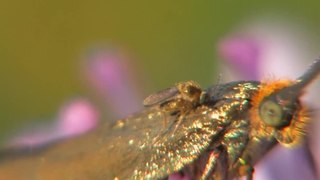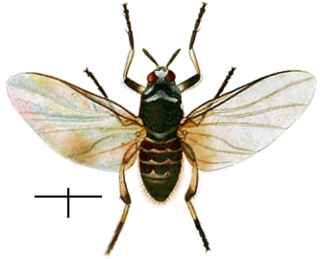 W
WAtrichopogon is a genus of biting midges, small flies in the family Ceratopogonidae.
 W
WAustrosimulium is a genus of 31 species of black flies that are distributed in Australia and New Zealand. There are 2 subgenera: Austrosimulium whose species are principally from New Zealand, and Novaustrosimulium which are exclusively Australian. Austrosimulium is a sister genus to the monospecific Paraustrosimulium of South America.
 W
WBezzia is a genus of biting midges in the family Ceratopogonidae. There are more than 310 described species in Bezzia.
 W
WCeratopogonini is a tribe of biting midges.
 W
WThe Chironomoidea are a superfamily within the order Diptera, suborder Nematocera, infraorder Culicomorpha. This superfamily contains the families Chironomidae, Ceratopogonidae, Simuliidae, and Thaumaleidae. One of the more important characteristics used to define them is the distinctive form of their larval mouthparts.
 W
WThe Culicoidini is a tribe of biting midges.
 W
WDasyhelea is a genus of biting midges and the only genus of its subfamily, the Dasyheleinae. Larvae of species in this genus are characterized by an anal segment with retractile posterior prolegs. Larvae are aquatic and adults do not feed on vertebrate blood, nor do they prey on other insects. They take nectar only, an unusual feeding behavior within the Ceratopogonidae.
 W
WForcipomyia is a genus of biting midges in the subfamily Forcipomyiinae. Species of the subgenus Lasiohelea suck vertebrate blood. Some species are ectoparasites on larger insects. Other species in the genus are important pollinators of the cacao tree. There are at least 1,000 described species in Forcipomyia.
 W
WHeteromyia is a genus of biting midges in the family Ceratopogonidae. There are about 17 described species in Heteromyia.
 W
WHeteromyia prattii is a species of biting midges in the family Ceratopogonidae from eastern North America.
 W
WHeteromyiini is a tribe of biting midges in the family Ceratopogonidae. There are about 5 genera and 16 described species in Heteromyiini.
 W
WThe highland midge is a species of small flying insect, found across the Palearctic in upland and lowland areas. In the north west of Scotland and northern Wales the highland midge is usually very prevalent from late spring to late summer. Female highland midges are well known for gathering in clouds and biting humans, though the majority of the blood they obtain comes from cattle, sheep and deer. The bite of Culicoides is felt as a sharp prick. It is often followed by irritating lumps that may disappear in a few hours or last for days, depending on the individual.
 W
WJenkinshelea is a genus of biting midges in the family Ceratopogonidae. There are about 18 described species in Jenkinshelea.
 W
WLeptoconops nosopheris is an extinct species of biting midges belonging to the family Ceratopogonidae. This species was described from fossilized remains preserved in Burmese amber from the Early Cretaceous. The amber containing the fossil was mined in the Hukawng Valley, in Kachin State, Myanmar
 W
WPalpomyiini is a tribe of biting midges in the family Ceratopogonidae. There are about 5 genera and more than 610 described species in Palpomyiini.
 W
WSerromyia is a genus of biting midges in the subfamily Ceratopogoninae.
 W
WSerromyia femorata is a species of biting midges. The species is noted for its peculiar mating practice: during mating, the ventral surfaces and mouthparts of the partners touch. After copulation, the female sucks out the body fluid of her mate through the mouth, thereby killing him, which may be a form of offspring provisioning through sexual cannibalism.
 W
WSimuliinae is a subfamily of black flies (Simuliidae). It contains over 2,200 species, with over 1,800 of them in the genus Simulium. There are 2 tribes and 25 living genera. A further 5 genera are known only from Cretaceous fossils.
 W
WThe Simuliini is a tribe of black flies that contains over 2,000 species, with more than 1,800 in the genus Simulium. There are 19 living genera, and three genera only known from Cretaceous fossils.
 W
WSimulium is a genus of black flies, which may transmit diseases such as onchocerciasis. It is a large genus with several hundred species, and 41 subgenera.
 W
WSimulium latipes is a species of fly in the family Simuliidae. It is found in the Palearctic.
 W
WSimulium variegatum is a species of fly in the family Simuliidae. It is found in the Palearctic.
 W
WSimulium yahense is a species of Black flies found in West African rain forests. Their larval stages are found in "smaller, more shaded, cooler breeding waters." One particular group, now eradicated, was found only on the island of Bioko, and was an extremely effective vector for the parasitic worm Onchocerca volvulus that causes onchocerciasis, or "River blindness".
 W
WSphaeromiini is a tribe of biting midges, insects in the family Ceratopogonidae. There are about 7 genera and at least 40 described species in Sphaeromiini.
 W
WStilobezzia is a genus of predaceous midges in the family Ceratopogonidae. There are more than 330 described species in Stilobezzia.
 W
WThaumalea verralli is a species of fly in the family Thaumaleidae. It is found in the Palearctic.